2.2 The four types of sources
Due to practical considerations the MeMO project began describing sources that had already been inventoried; these are sources covering the area that is currently the Netherlands. This is the reason why it is certain or highly probable that the sources included in the MeMO database functioned in medieval institutions in this area. The sources that were collected and described stem from the Middle Ages and the early modern period until the Reformation that took place in the larger part of the Netherlands around 1580. Only Noord-Brabant, Limburg, parts of Gelderland and Zeeuws-Vlaanderen remained catholic (even though the catholic and the reformed religion alternated with intervals until 1648). The final date of 1580 was maintained for these areas as well in the MeMO database. Most of the objects and texts stem from the fifteenth and sixteenth centuries.
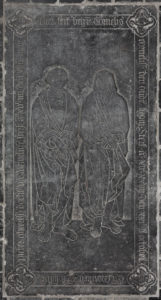
Fig. 1. Floor slab of a married couple in Kapelle (ca. 1500-1525), MeMO memorial object ID 3297
Objects and text carriers are usually considered to be two distinct types of memorial source. But this is clearly a formal distinction, as text carriers, i.e. manuscripts and printed books, are obviously material sources – and therefore objects. On the other hand, texts can also be present on objects, especially on objects that had a function in the commemoration of the dead. For these reasons the entire object has been the point of departure for the descriptions of all types of sources; they deal with all relevant aspects, as far as they are known.
The types of sources included in the database are the following:
1. Tomb monuments and floor slabs
There are various names for these objects which refer to their specific shape, but in general these objects were intended to indicate a burial place and to commemorate one or more persons who were buried there (fig. 1). Tomb monuments could be standing apart in the room, but could also be placed against a wall or in a recess. The MeMO database also includes cenotaphs, which were intended to commemorate people who were buried elsewhere. (For further information see chapter three.)
Websites
- De grafzerken van de Sint Jan te ’s-Hertogenbosch (Dutch).
- The floor slabs of Oudewater / De grafzerken van Oudewater (English and Dutch).
- Tombs on the Internet / Graven op het internet (English, Dutch, German, French and Spanish)
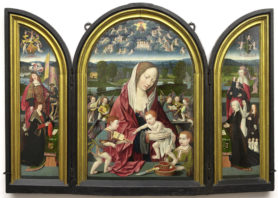
Fig. 2. Triptych with the Virgin and Child and the devotional portraits of the Sampsons-Coolen family from ’s-Hertogenbosch (1518). The girls in the white tunics had already died, as well as the boy behind the father holding a small red cross, MeMO memorial object ID 787
2. Memorial pieces (Memorialbilder)
The MeMO database contains a catalogue of memorial paintings and sculptures that were usually placed in chapels, churches, monasteries, and on the burial places that were connected to these institutions. Generally they consist of an image from the New Testament or a representation with saints combined with the devotional portraits of the people to be commemorated, often with their patron saints, and – where applicable – their heraldry, and with accompanying texts with the names and dates of death (fig. 2) (See for more information chapter three.)
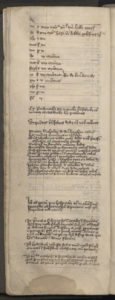
Fig. 3. Page from the register of gifts of the Cistercian monastery of Sibculo, covering the period 1406-1567, f. 9v, MeMO text carrier ID 430
3. Memorial registers
‘Memorial registers’ is a collective term for sources that had a liturgical and/or administrative function within the commemoration of the dead (fig. 3). For instance, calendars with persons to be commemorated were used in principle in the liturgy, while giftregisters, in which the donations and foundations of the benefactors were recorded, usually fulfilled a more administrative function.
It turns out that a categorisation of the memorial registers in documents with clearly distinct functions is problematic in the actual research practice. There are calendars that also record the donations and foundations besides the names of the persons to be commemorated. The registers of grave owners sometimes record the benefactions of the people to be buried. In short, memorial registers were designed and adapted as best fit the institution that used them. (See for further information chapter four.)
In the MeMO database the memorial registers are categorised according to their contents, and it provides options for the description of variations in the contents. It has the following categorisations:
- registers of graves, subdivided in
- burial places with the names of those buried
- registers of owners of graves
- registers of memorial services
- registers of gifts and foundations (donations registers)
- registers of pittances and doles
- registers of names not belonging to the aforementioned groups
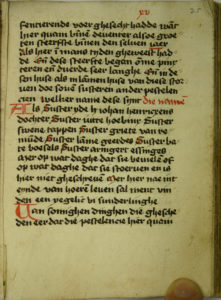
Fig. 4. ‘Zusterboek’ of the Lamme van Diesehuis in Deventer, f. 25r, with the names of nuns who died of pestilence in 1483. They are mentioned after the biography of their rector Egbert ter Beek, who had died in the same year, MeMO text carrier ID 279
4. Narrative sources regarding medieval memorial practices
Two groups out of the many types of narrative sources have been included in the MeMO database:
- historical sources that provide information on donations and memorial practices, such as chronicles of religious and ecclesiastical institutions.
- biographical sources that had a function in memorial practices, such as ‘zusterboeken’ (fig. 4), gesta commemorating the lives and important deeds of abbots and other ecclesiastical officials.
As is the case with memorial registers, here too one cannot make a clear distinction between chronicles and biographies that would make things so much easier for researchers. Even though similarities can be found in set-up and contents, institutions chose the form that best suited their purposes. (See for further information chapter four.)
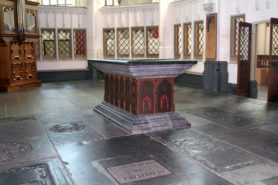
Fig. 5. Choir of the Stevenskerk in Nijmegen with floor slabs and the tomb monument of Catherine of Bourbon, Duchess of Guelders († 1469), wife of Adolf of Egmond. In her will she left a large sum for the foundation of a chapter in that church, MeMO memorial object ID 2324
The institutions in which the objects and text carriers functioned
If one is to put the memorial sources in their context and to interpret the various modes of use and function, information is required on the institutions (parish churches, monasteries, confraternities, etc.) from which these sources originate (fig. 5). Precise knowledge of the locations within the institutions where the objects and text carriers were used is important as well. This is the reason why the MeMO database includes a separate section with basic information on the original institutions. (See for more information chapter five.)
Sources for memoria research that have not (yet) been included
Besides the sources that have been included in the MeMO database there were various kinds of other types of objects and text carriers that fulfilled a function in the commemoration of the dead. These sources have not been included, because they have not (yet) been catalogued for the area that is now the Netherlands. These sources include the following:
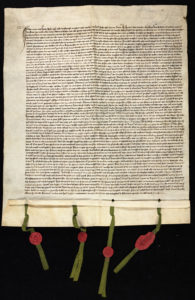
Fig. 6. Foundation charter of Mariënpoel convent near Leiden (1431). The founder, Boudewijn van Zwieten, stipulated prayer for the salvation of the souls of his family, his friends and the rulers he had served, Erfgoed Leiden en Omstreken, Kloosterarchieven, no. 860
- liturgical vessels, such as chalices, that commemorate the donors through a memorial representation or through heraldry
- foundation charters for monasteries, chapels and altars (fig. 6)
- last wills and testaments
- books of hours and prayer books containing the names of successive owners and their deceased family members
- books of hours and prayer books and other liturgical manuscripts containing more or less explicit mention of the scribe or author as a person to be commemorated
The database has been devised in such a way that descriptions of other sources can be incorporated at a later date, as well as inventories and descriptions of sources from other areas and other eras. An inventory of the sources from after 1580, for instance, would be of considerable value for the areas of the Netherlands that remained catholic and for the Southern Netherlands in general (fig. 7).
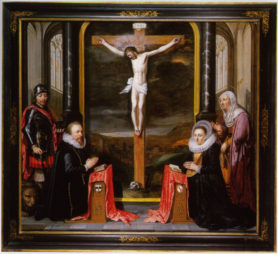
Fig. 7. During the Counter-Reformation the Church declared that living persons could no longer be portrayed in a religious image. As the husband of this Dordrecht couple was still alive when the painting was produced (1618), they are depicted kneeling in front of a painting showing the Crucifixion, Museum Catharijneconvent, Utrecht, St CC s30
Websites with inventories of written sources that have not been included in the MeMO database
- Cartago: Digitaal oorkondeboek Groningen en Drenthe (Dutch).
- Het Digitaal Oorkondeboek van Noord-Brabant (Dutch).

